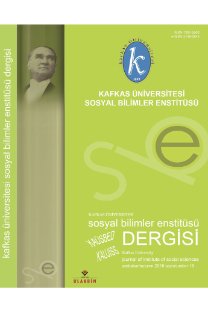ESKİÇAĞDA UZAK DİYARLARIN ULAŞIM ARACI: DEVE Transport Means of Distant Lands in Ancient Times: Camel
Transport Means of Distant Lands in Ancient Times: Camel
___
Akkuş Mutlu, S. (2017). Asur ve Urartu Devleti’nin Manna ülkesi üzerindeki hâkimiyet politikası. Akademik Tarih ve Düşünce Dergisi, Cilt 4, Sayı 11, s.225 – 239.Baskıcı, M. (1998). Evcilleştirme tarihine kısa bir bakış. Ankara Üniversitesi SBF Dergisi, C. 53, S. 1, s. 73-94.
Bulliet, R. W. (1990) The camel and wheel. Colombia University Press, New York.
Byrne, R. (2003). Early Assyrian contacts with Arabs and the ımpact on Levantine vassal tribute. Bulletin of the American Schools of Oriental Research, No. 331, s.11-25 CAD: The Assyrian Dictionary of the University of Chicago.
Chain, M. (1987). The kingdom of Armenia. Dorset, New York.
Crawford, H. E. W. (1973). Mesopotamia's ınvisible exports in the third millennium B.C.. World Archaeology, Vol. 5, No. 2, s. 232-241.
Çilingiroğlu, A. (1997). Urartu krallığı tarihi ve sanatı. Yaşar Eğitim ve Kültür Fakfı, İzmir.
Çoban, H. (2017). Eski çağda ilk evcil hayvanlar ve deve. Journal Of Social and Humanities Sciences Research, Vol. 4, s. 554-560.
Doğan, İ. B. (2008). Tarih öncesinde ticaret ve değiş tokuş. Arkeoloji ve Sanat Yayınları, İstanbul.
Frankel, D. (1979). The ancient kingdom of Urartu. British Museum Publications, London.
Grayson, A. K. (1996). Assyrian rulers of the early first millennium BC II (858-745 B.C.), Vol.3 (The royal ınscriptions of Mesopotamia. Assyrian periods, Vol. 3=RIMA 3). University of Toronto Press, Canada.
Horowitz, W. (2014). Sweeter than camel’s milk, the camel in Sumerian, the bactrian camel in Genesis?. Bible Lands e- Review, S.3, s. 1-9.
Irwin, R. (2010), Camel. Reaktion Books, London.
Katz, H. (2008). The ship from Uluburun and the ship from Tyre: An international trade network in the ancient Near East. Zeitschrift des Deutschen Palästina-
Vereins (1953-), Bd. 124, H. 2, s. 128-142.
Kılıç, Y. (2011). Eskiçağda Kapadokya’da at yetiştiriciliği. 1. Uluslararası Nevşehir Tarih ve Kültür Sempozyumu, C. 8, Nevşehir Ü. Yayınları, s. 189- 199.
Körpe, R. (2016). Develerin Batı Anadolu’ya ilk gelişleri ve antik çağ ordularında deve kullanımı. I. Uluslararası Selçuk-Efes Devecilik Kültürü ve Deve Güreşleri Sempozyumu Bildiriler, C. 1, s. 3-29.
Lambert, W. G. (1960). The domesticated camel in the second millennium— evidence from Alalakh and Ugarit. Bulletin of the American Schools of Oriental Research, No. 160, s. 42-43.
Luckenbill, D. D. (1926). Ancient records of Assyria and Babiylonia, VOL. I (ARAB I). The University of Chicago Press, Chicago.
Melikishvili, G. A. (1960). Urartskie klinoobraznye nadpisi. (UKN), Moskova.
Mierop, M. V. D. (2006). Antik yakındoğu’nun tarihi İÖ. 3000-323. Çev. Sinem Gül, Dost Kitabevi, Ankara.
Ouajd, S. & Kamel, B. (2009). Physiological particularities of dromedary (Camelus dromedarius) and experimental ımplications. Scandinavian Journal of Laboratory Animal Science, 36, No: 1, Denmark, s. 19-29.
Pehlivan, S. (2013). Urartu krallığı ve dış politikası: I. Sarduri (M.Ö. 844-828), İşpuini (MÖ. 828-810) ve Menua (M.Ö. 810-785) dönemi. History Studies, Vol. 5, S. 5.
Potts, D. (1984). On salt and salt gathering in ancient Mesopotamia. Journal of the Economic and Social History of the Orient, Vol. 27, No. 3, s. 225-271.
Rosen, S. A. & Saidel, B. A. (2010). The camel and the tent: An exploration of technological change among early pastoralists. Journal of Near Eastern Studies, Vol. 69, No. 1, s. 63-77.
Salvini, M. (2006). Urartu tarihi ve kültürü. Arkeoloji ve Sanat Yayınları, İstanbul.
Searight, S. (2013). The Pursuit Of A Celestial Stone. Asian Affairs, 44:3, s. 401- 417.
Seland, E. H. (2011). The Persian gulf or the Red sea? Two axes in ancient Indian Ocean trade, where to go and why. World Archaeology, 43:3, s.398-409.
Sever, H. (1987). Asur tarihinin ana devreleri. A.Ü. DTCF Dergisi, (Cumhuriyetin 60. Yıldönümü Armağanı), s.421-428.
Starr, C. G. (2000). Antik çağda deniz gücü. Çev: Gürkan Ergin, Homer Kitabevi, İstanbul.
The Cambridge ancient history (CAH), Vol. I, Part 2. (2008). Cambridge Universty Press.
The Cambridge ancient history (CAH), Vol. II, Part 2. (2008). Cambridge Universty Press.
The Cambridge ancient history (CAH), Vol. III, Part 2. (2008). Cambridge Universty Press.
Uerpmann, M. (2001). Remarks on the animal economy of Tell Abraq (Emirates of Sharjah and Umm al-Qaywayn,UAE). Proceedings of the Seminar for
Arabian Studies, Vol. 31, Papers from the thirty-fourth meeting of the Seminar for Arabian Studies held in London, 20-22 July 2000, s. 227-233.
Wilson Don, E & Reeder Dee, A. M. (2005). Mammal species of the World: A taxonomic and geographic reference. Johns Hopkins University Press, USA.
Zeder, M. A. (2006). Archaeozoology in Southwest Asia: A status report based on the eighth meeting of the archaeozoology of Southwest Asia and Adjacent Areas working group 2006. Paléorient, Vol. 32, No. 1, s. 137-147.
Zeder, M. A. (2012). The domestication of animals. Journal of Anthropological Research, Vol. 68, No. 2, s. 161-190.
- ISSN: 1307-5500
- Yayın Aralığı: 2
- Başlangıç: 2008
- Yayıncı: Kafkas üniversitesi Sosyal Bilimler Entitüsü
GEÇMİŞ ZAMANIN TARİHSEL ÜSTKURMACASI: KENDİNİ MEYDANA GETİREN ROMAN TO WHOM IT MAY CONCERN
YUSUF KILIÇ, SUZAN AKKUŞ MUTLU
ÖĞRETMEN METAFORLARINA İLİŞKİN KÜLTÜRLERARASI BİR ÇALIŞMA(TÜRKİYE VE AHISKA)1
LOJİSTİKTE TAŞIMA MODU SEÇİM KARARINA ETKİ EDEN FAKTÖRLERİN ANALİZİ
Elif BİLGİNOĞLU, Hava YAŞBAY KOBAL
GAZETE KÖŞE YAZILARININ TANIKLIĞINDA “ÇEVİRİCİ”
